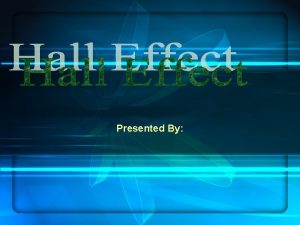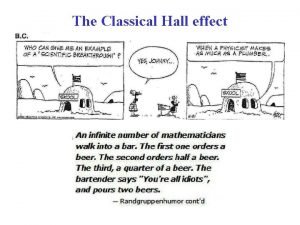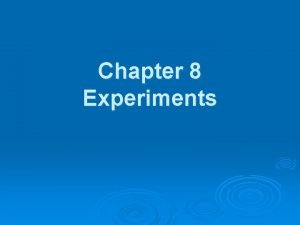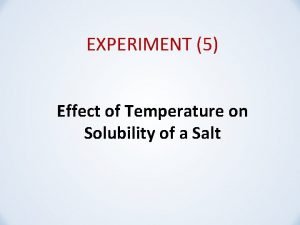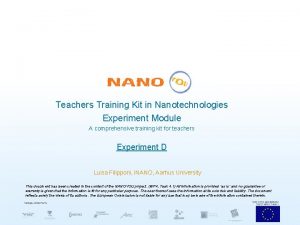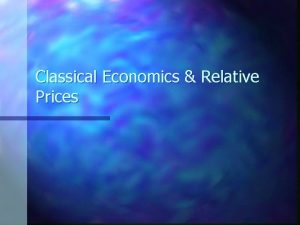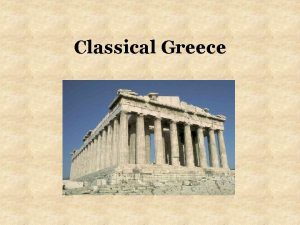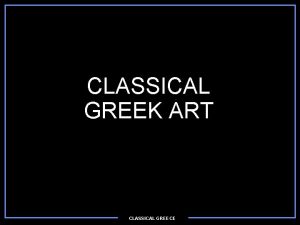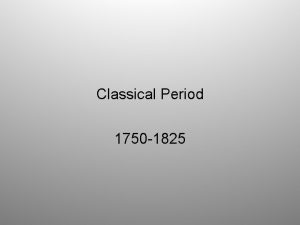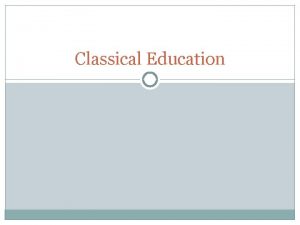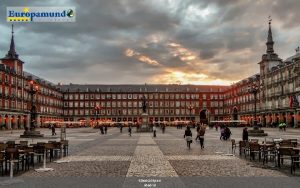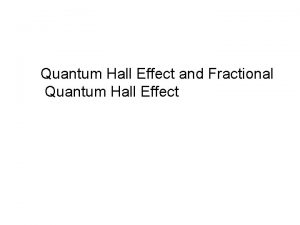The Classical Hall effect Standard Hall Effect Experiment







![Reminder: The Lorentz Force F = q[E + (v B)] Reminder: The Lorentz Force F = q[E + (v B)]](https://slidetodoc.com/presentation_image/55d74b0755933a171dba9c99dbcdb7ae/image-8.jpg)






- Slides: 14

The Classical Hall effect

Standard Hall Effect Experiment � e- v Current from the e+ v applied E-field Lorentz force from the magnetic field on a moving electron or hole E field Top view—electrons drift from back to front e- leaves + & – charge on the back & front surfaces– � � Hall Voltage The sign is reversed for holes

Electrons flowing without a magnetic field t semiconductor slice _ + d I I

When the magnetic field is turned on. . I q. Bv B-field

As time goes by. . . high potential q. E I q. Bv = q. E low potential

Finally. . . VH I B-field

Semiconductors: Charge Carrier Density via Hall Effect • Why is the Hall Effect useful? It can determine the carrier type (electron vs. hole) & the carrier density n for a semiconductor. • How? Place the semiconductor into external B field, push current along one axis, & measure the induced Hall voltage VH along the perpendicular axis. The following can be derived: n = [(IB)/(qw. VH)] • Derived from the Lorentz force FE = q. E = FB = (qv. B). Hole + charge Phys 320 - Baski Electron – charge Page 7
![Reminder The Lorentz Force F qE v B Reminder: The Lorentz Force F = q[E + (v B)]](https://slidetodoc.com/presentation_image/55d74b0755933a171dba9c99dbcdb7ae/image-8.jpg)
Reminder: The Lorentz Force F = q[E + (v B)]

Lorentz Force: Review The Velocity Filter: Undeflected trajectories in crossed E & B fields: E v= B Cyclotron motion: FB = mar qv. B = (mv 2/r) • Orbit radius: mv p r= = q. B • Orbit frequency: • Orbit energy: ω = 2π f = 1 K = 2 mv =2 q. B m q 2 B 2 R 2 2 m momentum (p) filter mass detection

The classical Hall effect 1400 1200 ly 1000 Slope related to RH and sample dimensions 800 600 400 Hallresistance-R xy(ohms) Ax 200 0 0 2 4 6 8 10 Magnetic field (tesla) • Lorentz force likes to deflect jx • However, E-field is set up which balances Lorentz force • Balance occurs when Ey = vx. Bz = Vy/ly • But jx = nevx (or ix = nevx. Ax) ⇒ Rxy = Vy / ix = RH Bz × (ly /Ax), where RH = 1/ne Where ly is transverse width of sample and Ax is the transverse cross sectional area of the sample, i. e. depends on shape of sample

The 2 D Hall effect • Surface current density sx = vxσ q, where σ is surface charge density • Again, RH = 1/σ e • However, now: Rxy = Vy / ix = RH Bz since sx = ix /ly and Ey = Vy /ly i. e. Rxy does NOT depend on the shape of the sample. This is a v. important aspect of the QHE

The integer quantum Hall effect Very important: For a 2 D electron system only First observed in 1980 by Klaus von Klitzing • Awarded Nobel prize in 1985 Hall conductance quantized in units of e 2/h, or Hall resistance Rxy = h/ie 2, where i is an integer. The quantity h/e 2 is now known as the "Klitzing" 1 Klitzing ≡ 25, 813 Ω Has been measured to 1 part in 108

The fractional quantum Hall effect The Royal Swedish Academy of Sciences has awarded The 1998 Nobel Prize in Physics jointly to Professor Robert B. Laughlin, Stanford University, California, USA, Professor Horst L. Störmer, Columbia University, New York and Lucent Technologies' Bell Labs, New Jersey, USA, and Professor Daniel C. Tsui, Princeton University, Princeton, New Jersey, USA. The three researchers are being awarded the Nobel Prize for discovering that electrons acting together in strong magnetic fields can form new types of "particles", with charges that are fractions of electron charges. Citation: "for their discovery of a new form of quantum fluid with fractionally charged excitations. " Electrons in New Guises Horst L. Störmer and Daniel C. Tsui made the discovery in 1982 in an experiment using extremely powerful magnetic fields and low temperatures. Within a year of the discovery Robert B. Laughlin had succeeded in explaining their result. Through theoretical analysis he showed that the electrons in a powerful magnetic field can condense to form a kind of quantum fluid related to the quantum fluids that occur in superconductivity and in liquid helium. What makes these fluids particularly important for researchers is that events in a drop of quantum fluid can afford more profound insights into the general inner structure and dynamics of matter. The contributions of the three laureates have thus led to yet another breakthrough in our understanding of quantum physics and to the development of new theoretical concepts of significance in many branches of modern physics.

 Hall effect definition
Hall effect definition Hall effect in semiconductor
Hall effect in semiconductor Experiment
Experiment Effect of temperature on solubility
Effect of temperature on solubility Lotus effect experiment
Lotus effect experiment Hát kết hợp bộ gõ cơ thể
Hát kết hợp bộ gõ cơ thể Frameset trong html5
Frameset trong html5 Bổ thể
Bổ thể Tỉ lệ cơ thể trẻ em
Tỉ lệ cơ thể trẻ em Voi kéo gỗ như thế nào
Voi kéo gỗ như thế nào Thang điểm glasgow
Thang điểm glasgow Chúa yêu trần thế alleluia
Chúa yêu trần thế alleluia Các môn thể thao bắt đầu bằng tiếng nhảy
Các môn thể thao bắt đầu bằng tiếng nhảy Thế nào là hệ số cao nhất
Thế nào là hệ số cao nhất Các châu lục và đại dương trên thế giới
Các châu lục và đại dương trên thế giới
